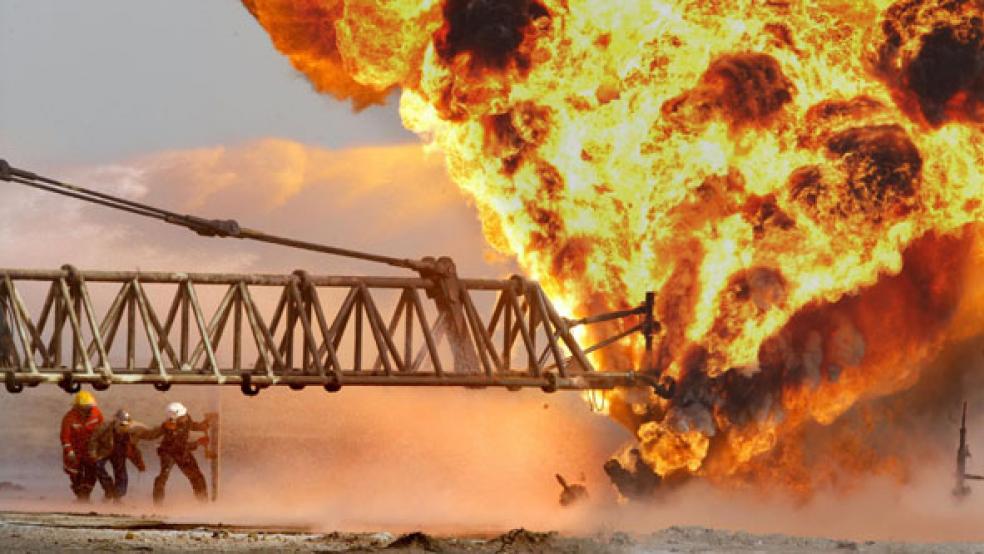Curious thing about the turmoil in Syria—it suggests that America is breaking its decades-long oil addiction.
Chaos in the Middle East usually sends prices soaring at the pump. Not this time. Heading into Labor Day, gasoline averaged $3.59 a gallon. That’s a slight increase over the past week. But gas still dropped 6 percent from a year ago and a few cents over the past month, according to the AAA’s Daily Fuel Gauge Report.
One reason for the falling prices has been a decline in usage. American drivers burned through 9.09 million barrels of gasoline a day in 2007, according to the Energy Department. That average dropped to 8.44 million a day in the first five months of this year—a 7.7 percent decrease.
“We are seeing the beginning of the end of an era of high gasoline prices,” said Phil Flynn, senior market analyst for the Price Futures Group. “We are as a country better positioned in our gasoline market than we have been in decades.”
There are several reasons for this:
• OPEC no longer has as tight a grip over consumers as it did during the 1970s, as new fracking technologies have boosted domestic oil and natural gas reserves by more than 35 percent, according to the Energy Department. North Dakota has suddenly emerged as the center of an economic boom.
• An aging population means drivers are logging fewer miles on the road, so baby boomers will likely demand less gasoline with each passing year. The Federal Highway Administration found that drivers between the ages of 55 to 64 years old average 11,972 miles on the road, a total that drops to 7,646 once they pass the age of 65.
• At the same time, gas mileage has improved. President Obama raised fuel standards last year, mandating that cars and light trucks will average 54.5 miles-per-gallon by 2025. This should save $8,000 over 13 years for a typical American family, according to White House estimates. “These fuel standards represent the single most important step we’ve ever taken to reduce our dependence on foreign oil,” Obama said at the time.
• Over the last year, electric car company Tesla has become a darling of Wall Street investors and Consumer Reports—which gave the Model S its highest rating of all-time. Despite the mixed reception of the Chevy Volt and Nissan Leaf, Tesla’s rise has analysts believing that the era of gasoline engines is drawing to a close.
RELATED: WILL A MILITARY STRIKE IN SYRIA SINK THE STOCK MARKET?
This all indicates that—despite seasonal differences—daily gasoline usage will continue to drop from its peak of 9 million barrels a day.
“I hate to put numbers on it, but do I think we could get below 8 million? Absolutely,” said Flynn. “Could we get below 7 million? Absolutely. … We’re rewriting history as we speak, writing the last chapter of the gas guzzler.”
For all the concerns caused by a lukewarm economic recovery, the United States has—since the 2008 oil price spike—benefitted from its waning reliance on petroleum. The change from last year—when Americans spent a record percentage of their paychecks on gasoline—could not be more pronounced. It just might be the most underappreciated shift in the economy, one that insulates the country from geopolitical shocks such as the potential military intervention Syria that Obama is putting before Congress.
In fact, oil and gasoline prices are poised to drop, even if the United States and its international partners retaliate against Syrian President Bashar al-Assad for his use of chemical weapons in that country’s civil war.
“Despite some of the rhetoric you hear and saber rattling about a big Persian Gulf War, you won’t see tremendous disruptions out of the region,” said Tom Kloza, chief analyst at the Oil Price Information Service. “My instincts tell me we’re going to move lower.”
Kloza explained that the United States is “much more insulated vis-à-vis global oil price shocks than we were during the first Arab Spring” in 2011 when the governments of Egypt, Libya, and Tunisia were overthrown. U.S. production is roughly two million barrels a day higher than in the first quarter of 2011.
Most of the 400,000 barrels a day pumped out by a pre-civil war Syria was exported to Europe. That output has shrunk to 50,000 barrels a day. If the fighting in Syria spread across the Middle East, it would put at risk 1.85 million barrels a day that Saudi Arabia, Iraq and Kuwait export to the United States.
Production in America and Canada can provide 10-million daily barrels—more than half of what the United States needs. “Throw in Mexico and other ‘friendlies’ and we are nowhere near as vulnerable as we were in 2003 or 1990,” said Kloza, referring to past incidents in which the United States waged war against Iraq.
But more importantly, the market is pointing to lower prices as Americans come out of what has been a return the traditional summer driving season in July and August. The futures market suggests that gasoline costs for the end of the year will be about $2.90 a gallon, according to Kloza’s analysis.
Even if oil prices climb in response to what happens in Syria, U.S. motorists should be safe from any of the swings, Kloza concluded in a written overview.
“Without question, the U.S. will fare better than every other [country] if the sabers are unsheathed,” he wrote




